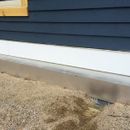Best backfill material for frost protected shallow foundation?
We have a frost protected shallow foundation (monolithic slab) at our house in NH (zone 6), there is 4″ of XPS for the slab edge (protected by the aluminum flashing) and wing insulation. The white material is cellular PVC board and then spruce clapboards.
When we finished the insulation, we covered it in some leftover screened sand to protect it before we were ready for landscaping. I’ve attached a photo showing some sand scraped away, there’s anywhere from 2-6″ currently on the wing insulation depending on location.
We’ll bring the final grade (sloped away from the house) up to the top of the vertical part of the aluminum flashing and we’ll also have a crushed stone drip edge around the house.
I’ve looked over dozens of photos/diagrams, but looking for some advice on the best material to use now that we are working on some landscaping:
-use the existing sand for the whole depth right next to the house? because it could dry faster and drain water through?
-strip the sand and use all screened loam? because it’s more stable and less porous?
-layer of sand on top of wing foam and layer of loam below drip edge stone to shed water?
I’m wondering if I’m overthinking this and should just use all screened loam because it will consolidate and be stable….or is there some benefit to incorporating the available sand?
Thanks!
GBA Detail Library
A collection of one thousand construction details organized by climate and house part










Replies
Brian,
The usual material at this location is ordinary topsoil -- ideally, topsoil that has a high percentage of clay rather than sand, if you have a choice, to encourage rain to flow away from the house.
What's behind the horizontal PVC trim? I assume that you have OSB or plywood sheathing and wood framing behind there. My own vote is to keep the finish grade lower than you are planning -- splashback and rain will keep the lower section of your wall damp, and even the PVC trim may not adequately protect the sheathing behind the trim from rot.
Carpenter ants love tunneling through XPS! It needs to be coated with a cement based coating to keep them out. Aluminum flashing won't do it, and being in the ground it will deteriorate with time.
I'm not sure if I can source anything other than "screened loam" in this area, but I'll look into it.
It is wood framing and Advantech sheathing behind the PVC trim, although there is a continuous layer of Grace Vycor Plus protecting the sheathing behind the PVC trim and a few inches higher behind the first clapboard or so.
Thanks for the advice on the finish grade. We'll definitely keep it below the PVC board and the top layer near the house will be crushed stone; the 1.5' roof overhang and metal roof also help keep the splash area 20"+ away from the wall.
Bob, I hear you on the vulnerability of the XPS. Detailing and finishing this type of slab has made me wonder whether other slab types would be better.
Many photos and diagrams I've seen of these types of slabs show most of the wing insulation exposed to soil below ground. I thought we were following best (or at least good) practice with what we did.
Given this current setup, are you suggesting trimming back the vertical part of the aluminum flashing and refinishing the slab edge XPS with a cement based coating? And even taking the coating onto the wing insulation?
I honestly don't know if we have the energy/time to tackle this after a long/stressful 1.5 years of building, but I'd consider it.
Thanks for your advice.
Brian P,
I think you are over thinking this. We have excavated additions, razed buildings, removed insulated slabs, etc many of which have had below grade foam insulation. I can't recall a single one of these foam insulated areas that were damaged by carpenter ants. Keep in mind I'm from Wisconsin, so we have cold winters. We don't have termites in this area. We do have carpenter ants, but they are only seen in conjunction with wet wood.
That being said, pulverized clay material would be the best. Ask your local topsoil guys if they can get you a load of pulverized clay. It depends on their equipment. Some loam is simply sifted on a screen deck. Since we have heavier clay soils in my region (even the loam has a higher clay content) we use ground processing equipment that is like a hammer mill. It is first pulverized and then screened.
The pulverizing process makes a nice workable material that is easy to shovel and rake by hand. People may be surprised that you are asking for clay, but keep asking. Incidentally, pulverized clay is one of the main ingredients in "infield mix" for baseball diamonds.
Brian,
You may want to check what your code says about finished grade. Ours requires 8" between the soil and top of foundation.
Rick,
Admittedly we probably have more carpenter ants than most places here in the PNW, but I don't have to go further than my back door to find foam damaged by infestations.
The widespread belief that they will only attack damp foam or wood isn't borne out by our experience here. They like to tunnel through XPS foam, as it closely mimics the decaying stumps they usually nest in.